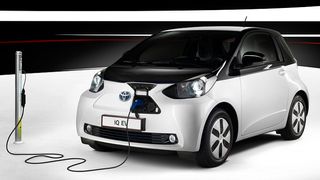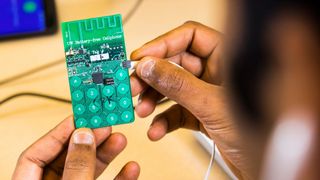The future of batteries, from human power to a wireless grid
Why aren't we there yet?

Extending the battery life of our tech is something that preoccupies manufacturers and consumers alike. With every new phone launch we're treated to new features, such as increasingly high-res displays and better cameras, but it’s longer battery life we all want.
For most of us, being able to use our phone for a full day still means charging it every night, or lugging your charger around all day and hunting for a power socket. And when the electric car revolution reaches full speed, fast-charging, long-life batteries are going to be essential.
Advances in battery life are being made all the time, even if we're yet to see the full benefits in our day-to-day gadgets.
But what’s beyond that? Wireless power. And we don’t mean laying our phone on a charging pad – we’re talking about long-range wireless power. If this is cracked we could have all our devices at full juice all the time, no matter where we are.
The current tech
The batteries in your current phone, and in electric cars, are lithium-ion. These charge quickly, last for plenty of cycles and offer decent capacity. But devices are more juice-hungry than ever, and with cars in particular fast charging needs to become more effective, because batteries aren’t going away any time soon.
While wireless power could be a viable option in the future, in the short-to-medium term we need to enhance batteries so that individuals and energy providers can first transition from fossil fuels to green renewable power.

Louis Shaffer of power management solutions firm Eaton tells TechRadar: “We constantly hear about battery breakthroughs but still have the same lithium-ion batteries in our phones. Innovation takes time. It took over 30 years for li-ion batteries to enter the mainstream, from their invention in the 1980s to featuring in iPhones.”
Get daily insight, inspiration and deals in your inbox
Get the hottest deals available in your inbox plus news, reviews, opinion, analysis and more from the TechRadar team.
Another factor in slowing this progress is highlighted by Chris Slattery, product manager at smart lighting manufacturer Tridonic. “The interesting point with mobile phones is that one of the major factors for upgrading your phone is the degradation of the current phone’s battery life,“ he says.
“Increasing the life of these batteries removes a major reason for upgrading to the latest smartphone when the feature set itself doesn't change that greatly.”
Ultracapacitors
Ultracapacitors are seen by many as the future of energy storage, as they store energy in an electric field, rather than in a chemical reaction as a battery does, meaning they can survive hundreds of thousands more charge and discharge cycles than a battery can.
Taavi Madiburk is CEO of Skeleton Technologies, a global leader in ultracapacitor-based storage solutions. He says: “The future, we believe, lies not in replacing lithium-ion, but coupling this technology with ultracapacitors in a hybrid approach.
"In doing so, it is possible to benefit from both the high energy density of batteries, and the high power density and output of ultracapacitors.

“Ultracapacitors can be re-charged in a matter of 2-3 seconds, providing one million deep charge/discharge cycles. Also, with ultracapacitors protecting batteries from high power surges, the lifetime of the battery pack is increased by 50% and the range by 10%.
Skeleton is already working to improve power grids to cater for the growing number of electric cars. It sees current large-scale electrical grids being replaced in certain areas by smaller, less centralized grids called microgrids, and, Madiburk adds, “We’re currently working on with ultracapacitors as a piece of that puzzle.”
Solid state batteries
One of the major advances in battery tech right now sticks with good old lithium.
Solid-state lithium batteries dispense with the electrolyte liquid that transfers charged particles, making them safer than current batteries yet still able to operate at super-capacitor levels, meaning that charging and discharging can happen faster.
This is great for car batteries, as it means more power can be utilized by the car for quick pull-away speed, but fast charging will mean drivers need to spend less time at charging stations.
One example of this, from Toyota scientists, is a battery that can be fully charged from empty in just seven minutes.

Another promising area is aluminium-air batteries, which have been placed in a car to deliver a whopping 1,100 miles on a single charge. Then there are sand-based batteries, which - while still lithium-ion - manage to offer three times better performance than lithium-ion while being cheaper to make, non-toxic and environmentally friendly.
Whisper it, but one of the big hopes for improved batteries for a while now has been graphene. The Grabat battery from Graphenano charges 33 times faster than lithium-ion units, and can deliver high power too, making it ideal for cars.
Battery-free phones
One way to go without batteries is to make gadgets super-low power consuming. A phone has been built that doesn't even require a battery, so low are its power needs – and it was achieved using components that are available to anyone.
Engineers at the University of Washington designed the phone, which is able to pull power from the environment, with radio signals and light harvested by an antenna and tiny solar cell.

The result is enough power to run the 3.5 microwatt-consuming phone. You’re limited to making calls only, but the idea having a tiny credit card-sized backup phone in your wallet will appeal to everyone from constantly on-the-move workers who need to stay in touch, to hikers.
Ambient power
Other breakthroughs have also been based on drawing ambient power from the world around us. One such technology uses sound and nanogenerators, so that simply talking into your phone generates power to charge it.
MIT scientists, meanwhile, have shown off a way to harvest power from water dew in the air; they've only been able to create a potential one microwatt so far, but combine these methods, throw in a bit more evolution and we could be looking at a battery-free future.
Over the air power
The dream of transmitting power over the air has existed since the days of the legendary inventor and electrical engineer Nikolas Tesla, but it’s only recently started to become a reality. One company that claims to have mastered the technology, taking it beyond the close-range Qi wireless charging now found in many smartphones, is uBeam.
The uBeam system was cracked by 25-year-old astrobiology grad Meredith Perry, who has since received over $28 million in funding.
This system uses microwaves to transmit energy several metres across a room to power devices. Perry has shown it off charging phones, but says it could be applied to TVs, computers and even cars.

It uses a lot of power, costs a lot to manufacture and offers a pretty slow charging rate; but there are no wires to be seen, and this way of delivering power could hail a future without batteries.
If it could be made efficient on a large scale, in a similar way to mobile phone networks, all our devices could draw power from such a system. Imagine phones and electric cars that never need charging.
But is this future as close as uBeam would have its investors and us believe? Probably not.
Human power
This is where things get really interesting – harnessing the power of human beings. Not like in The Matrix, where we’re reduced to a glorified battery, but through friction generated by movement.
Scientists have shown off the tech in action, powering 12 LED bulbs. That’s not going to change the way you use your gadgets right now, but it’s a step in the right direction.
The technology uses a 50nm thin gold film sitting under silicone rubber nanopillars which create maximum surface area with the skin. The result is lots of friction, and all the user has to do is strap the unit on, making it ideal for wearables.
And the Bill Gates Foundation has even developed a process that harvests enough power from our urine to charge a phone, dubbed the Microbial Fuel Cell; that's pretty much the definition of sustainable power.
This article is brought to you in association with Vodafone.
Luke is a freelance writer and editor with over two decades of experience covering tech, science and health. Among many others he writes across Future titles covering health tech, software and apps, VPNs, TV, audio, smart home, antivirus, broadband, smartphones, cars and plenty more. He also likes to climb mountains, swim outside and contort his body into silly positions while breathing as calmly as possible.
Most Popular


